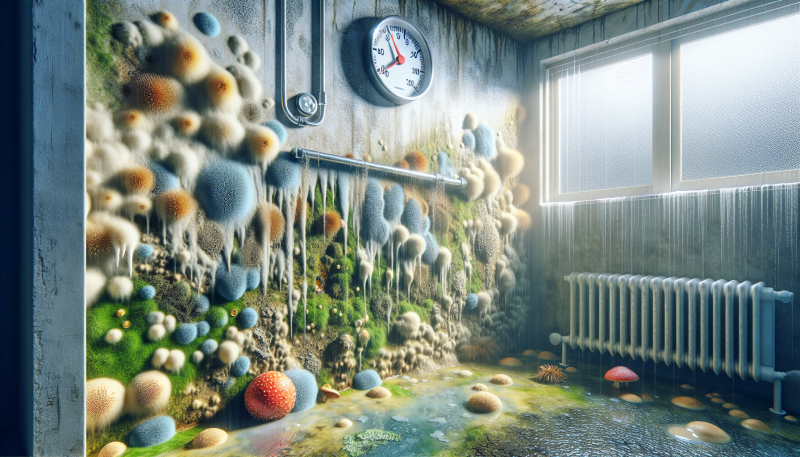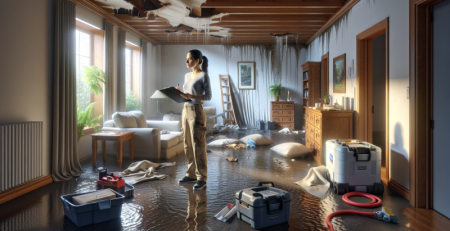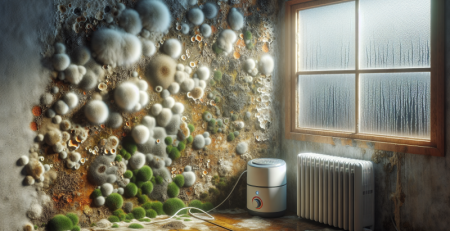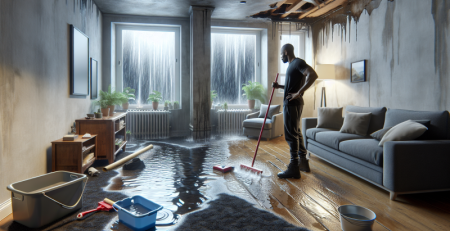The Connection Between Humidity and Mold Growth
Understanding the connection between humidity and mold growth is crucial for homeowners and property managers, especially in regions like Central and Northern New Jersey, where moisture levels can fluctuate significantly. High humidity creates an ideal environment for mold spores to thrive, leading to potential health risks and property damage. At Kraus Restoration, NJ’s leaders in water damage restoration, we recognize the importance of addressing humidity issues promptly to prevent mold infestations. Our mission is to help those affected by water damage, mold, and other disasters by providing professional, 24/7 emergency services. With our IICRC certified experts, we ensure thorough mold cleanup and remediation, safeguarding your home and health. In this blog, we will explore how humidity levels influence mold growth and offer practical tips to keep your living spaces safe and dry. Whether you’re dealing with stormwater runoff, sewage backup, or simply high indoor humidity, understanding this connection is the first step toward effective prevention and restoration.
Understanding Humidity Levels and Their Impact on Indoor Environments
Humidity is a critical factor in determining the quality of indoor environments, influencing not only comfort levels but also the potential for mold growth. Understanding humidity levels is essential for maintaining a healthy living space, as excessive moisture can lead to various problems, including structural damage and health issues.
Humidity is defined as the amount of water vapor present in the air. It is typically expressed as a percentage, known as relative humidity (RH), which indicates how much moisture the air contains compared to the maximum amount it can hold at a given temperature. For instance, at 70°F, air can hold a maximum of about 8.5 grams of water per cubic meter. If the air contains 6 grams of water, the relative humidity would be approximately 70%.
The ideal indoor humidity level is generally between 30% and 50%. When humidity levels fall below this range, the air can become too dry, leading to discomfort, respiratory issues, and increased static electricity. Conversely, when humidity levels exceed 60%, the environment becomes conducive to mold growth, dust mites, and other allergens. Mold spores thrive in damp conditions, and when humidity levels are high, these spores can settle on surfaces and begin to grow, often within 24 to 48 hours.
Mold growth can have serious implications for both health and property. According to the Environmental Protection Agency (EPA), mold can cause a range of health problems, particularly for individuals with respiratory conditions, allergies, or weakened immune systems. Symptoms may include nasal congestion, throat irritation, coughing, and skin rashes. In some cases, exposure to mold can lead to more severe health issues, such as asthma attacks or respiratory infections.
In addition to health concerns, mold can also cause significant damage to buildings and furnishings. It can weaken structural components, damage walls, ceilings, and floors, and lead to costly repairs. The presence of mold can also decrease property values and make homes less appealing to potential buyers.
To effectively manage humidity levels and prevent mold growth, it is essential to monitor indoor humidity regularly. Humidity can be measured using a hygrometer, a simple device that provides real-time readings of moisture levels in the air. Homeowners should aim to keep humidity levels within the recommended range and take action if levels rise above 60%.
There are several strategies to control humidity in indoor environments:
-
Ventilation: Proper ventilation is crucial for reducing humidity levels. This can be achieved through the use of exhaust fans in bathrooms and kitchens, opening windows to allow fresh air circulation, and ensuring that air ducts are clean and unobstructed.
-
Dehumidifiers: Using a dehumidifier can help remove excess moisture from the air, particularly in areas prone to dampness, such as basements. Dehumidifiers come in various sizes and capacities, making it easy to find one suitable for specific spaces.
-
Air Conditioning: Air conditioning systems not only cool the air but also help reduce humidity levels. Regular maintenance of these systems is essential to ensure they operate efficiently.
-
Moisture Control: Addressing sources of moisture is vital. This includes fixing leaks in roofs, walls, and plumbing, as well as ensuring that gutters and downspouts direct water away from the foundation of the home.
-
Insulation: Proper insulation can help prevent condensation on walls and ceilings, which can contribute to mold growth. Insulating attics and crawl spaces can help maintain consistent indoor temperatures and reduce humidity.
-
Humidity-Resistant Materials: When renovating or building, consider using materials that are resistant to moisture, such as mold-resistant drywall and paints. These materials can help mitigate the risk of mold growth in high-humidity areas.
-
Regular Cleaning: Keeping indoor spaces clean and dry is essential. Regularly cleaning surfaces, especially in areas prone to moisture, can help prevent mold spores from settling and growing.
-
Monitoring Indoor Plants: While indoor plants can improve air quality, they can also contribute to humidity levels. Be mindful of how many plants you have and their watering needs, as overwatering can increase indoor humidity.
-
Humidity Control Systems: Advanced humidity control systems can be integrated into HVAC systems to automatically adjust humidity levels based on real-time data.
By implementing these strategies, homeowners can effectively manage humidity levels and reduce the risk of mold growth in their indoor environments.
In summary, understanding humidity levels is crucial for maintaining a healthy indoor environment. High humidity can lead to mold growth, which poses health risks and can cause significant property damage. By monitoring humidity levels and taking proactive measures to control moisture, individuals can create a safer and more comfortable living space. For more information on how to manage humidity and prevent mold growth, consider exploring our mold cleanup services or learn more about our water cleanup services. If you have any questions or need assistance, feel free to contact us for expert guidance.
References:
- Environmental Protection Agency. “Mold Remediation in Schools and Commercial Buildings.” EPA, 2001. https://www.epa.gov/mold/mold-remediation-schools-and-commercial-buildings-guide
- American Society of Heating, Refrigerating and Air-Conditioning Engineers. “ASHRAE Standard 55: Thermal Environmental Conditions for Human Occupancy.” ASHRAE, 2017. https://www.ashrae.org/technical-resources/standards-and-guidelines/standards-55
- Centers for Disease Control and Prevention. “Mold and Health.” CDC, 2020. https://www.cdc.gov/mold/default.htm
Effective Strategies for Controlling Humidity to Prevent Mold Growth
Controlling humidity is crucial in preventing mold growth, which can pose serious health risks and damage to property. Mold thrives in environments where humidity levels exceed 60 percent, making it essential to maintain optimal indoor humidity levels, ideally between 30 and 50 percent. There are several effective strategies to manage humidity levels in your home or workplace, ensuring a healthier environment and reducing the risk of mold infestations.
One of the most effective ways to control humidity is through the use of dehumidifiers. These devices work by drawing moisture from the air, making them particularly useful in areas prone to high humidity, such as basements and bathrooms. When selecting a dehumidifier, consider the size of the space and the unit’s capacity to remove moisture. Regular maintenance, including cleaning the filter and emptying the water reservoir, is essential for optimal performance.
Proper ventilation is another key strategy in humidity control. Ensuring that your home is well-ventilated allows for the circulation of fresh air, which can help reduce moisture levels. This can be achieved by opening windows, using exhaust fans in kitchens and bathrooms, and installing vents in attics and crawl spaces. In addition, using air conditioning can help lower humidity levels, as air conditioners not only cool the air but also remove moisture.
Insulation plays a significant role in humidity control as well. Properly insulating your home can prevent condensation on walls and ceilings, which is a common cause of mold growth. Pay special attention to areas that are prone to moisture, such as attics, basements, and around windows. Sealing any gaps or cracks in your home can also help keep humid air out and maintain a stable indoor environment.
Monitoring humidity levels is crucial for effective control. Using a hygrometer, you can easily track the humidity levels in your home. If you notice that humidity levels are consistently high, it may be time to implement additional measures, such as increasing ventilation or using a dehumidifier more frequently.
In addition to these strategies, it is important to address any sources of moisture in your home. Leaky roofs, plumbing issues, and poor drainage can all contribute to increased humidity levels. Regular inspections and maintenance can help identify and resolve these issues before they lead to mold growth. If you suspect that mold is already present, it is advisable to seek professional help for mold cleanup to ensure that it is safely and effectively removed.
Finally, consider the materials used in your home. Certain building materials, such as drywall and carpeting, can absorb moisture and promote mold growth. Opting for mold-resistant materials can significantly reduce the risk of mold infestations. Additionally, using moisture-resistant paint in areas prone to humidity can provide an extra layer of protection.
By implementing these effective strategies for controlling humidity, you can create a healthier living environment and significantly reduce the risk of mold growth. Regular maintenance, monitoring, and proactive measures are key to ensuring that humidity levels remain in check. For more information on how to protect your home from mold and moisture issues, feel free to explore our services or contact us for expert advice and assistance.
In conclusion, understanding the connection between humidity and mold growth is crucial for maintaining a healthy living environment. High humidity levels create the perfect breeding ground for mold spores, which can lead to a range of health issues and structural damage to our homes. By monitoring indoor humidity and taking proactive measures to control it—such as using dehumidifiers, ensuring proper ventilation, and promptly addressing leaks—we can significantly reduce the risk of mold proliferation. Awareness and action are key; by prioritizing humidity control, we not only protect our homes but also safeguard our health and well-being. Remember, a little prevention goes a long way in keeping mold at bay.










